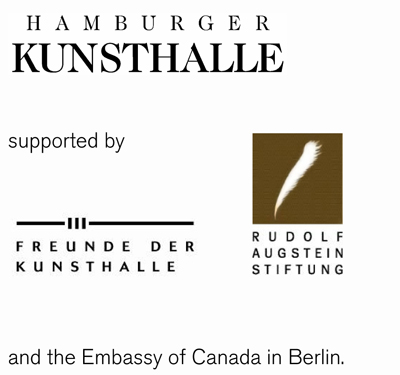Rodney Graham.
Through the Forest
22 October 2010 – 30 January 2011
Gallery of Contemporary Art
Hamburger Kunsthalle
Glockengiesserwall
20095 Hamburg
Germany
Graham made his first large photographic work, 75 Polaroids, in 1976. This series of snapshots taken during a night-time walk through the forests around Vancouver was exhibited at Pender Gallery in Vancouver; it was Graham’s first solo exhibition and marked the beginning of his career as an artist. 75 Polaroids contains elements that would be essential to his later works, namely his fascination with photographic processes, which transform objects from mere representations to autonomous images, and the idea of illuminating places at night via flash. The polaroid series Montserrat (1995), a mountain in Catalonia where the Holy Grail was assumed, and also the video installation Edge of a Wood (1999) in the cupola hall of the Kunsthalle’s main building follow this line of investigation.
In 1986, Rodney Graham came across an English translation of the story Lenz by the German Romantic author Georg Büchner. In that translation, Graham discovered a peculiarity of the layout: the words ‘Through the forest’ appear twice at points where the story continues from one page to another. For him, the text became a loop, as the term is used in film terminology, and a key element to later works. Graham constructed a reading machine that he employed to make this experience both vivid and visible. The first five pages on which he recognised this phenomenon in the layout of the text are arranged so that the rotational effect becomes tangible.
The exhibition focuses on his later films, which, on a formal level, further the tradition of conceptual-text works and light phenomena. For the film Coruscating Cinnamon Granules (1996), Graham strewed ground cinnamon onto the stove in his kitchen and filmed the glowing specks; the space in which this film is shown has the same dimensions as the kitchen where it was made. Rheinmetall/ Victoria 8 (2003) is inspired by an almost unused 1930s German typewriter which Graham acquired from a second-hand shop in Vancouver. First, he documented the object in the style of New Objectivity; then he covered it with flour creating a poignant image for words falling silent.
Another part of the exhibition deals with the role of the artist. In the film Lobbing Potatoes at a Gong, 1969 (2006), Graham re-enacts a fictive performance scene from the late sixties which was initiated by an anecdote from the history of rock music in which the drummer of Pink Floyd threw potatoes at a gong in a concert. In Graham’s piece, the potatoes are transformed into vodka which then becomes part of the installation. It is these kinds of ‘processes of translation’ which the artist is interested in, something originating in music or literature becomes physical as it is rendered in another medium. My Only Novel Translated from the French (After William Beckford, Mark Twain), (2000), in which the French translation of the English original is translated back into English, is a direct example of this.
The role of the artist is also explored in the monumental triptych The Gifted Amateur, Nov. 10th, 1962 (2007). In this work, Graham is an amateur painter who attempts to reproduce a large-format abstract expressionist painting. The scene in the light-box piece makes it looks like a film still. Graham plays on the art historical discourse of Modernity in which diverse directions are represented. In the exhibition, Rodney Graham also presents himself as a painter who turns to the painting of the École de Paris to produce abstractions in the style of that period, thus following a similar strategy as with the painting series Picasso, My Master (2005) which is also on view.
Through the Forest displays a long path that goes from the adaptation of literary models and the appropriation of moments in art history to impressive film works and painting. Graham’s use of appropriation allows him to pay tribute to some artists, writers, philosophers and musicians, though not without playfully demystifying their influence. His exhibition relates perfectly to the Hamburger Kunsthalle’s collection with its significant focus on works of art from the Romantic period. Manifold are the connections to the Gallery of Contemporary Art holdings of Minimal and Conceptual Art particularly with the series of works based on objects by Donald Judd or Dan Graham. And also the remarkable collection of artists’ books in the Department of Prints, Drawings and Photography form a context for the many book objects Graham has produced.
Born in 1949 in Abbotsford, in British Columbia, Rodney Graham studied art history and anthropology, as well as English and French literature in Vancouver. Aside from numerous international exhibitions at the Vancouver Art Gallery; the Dia Center for the Arts, New York; the Whitechapel Art Gallery, London; Kunsthalle Zurich; K21, Duesseldorf and others, he was a participant of documenta 9 in 1992 and represented Canada at the Venice Biennial in 1997.
The exhibition catalogue, published in German and English, is available for 35 Euro from the museum’s shops and at www.freunde-der-kunsthalle.de.
The Exhibition was organised by the Museu d’Art Contemporani de Barcelona (MACBA) in collaboration with the Museum für Gegenwartskunst, Basel and the Hamburger Kunsthalle.
Curator: Sabrina van der Ley
Also on view at Hamburger Kunsthalle: DAVID TREMLETT: DRAWING ROOMS until 9th of January 2011 and the group exhibition CUT – PAPER CUTS 1970 – 2010 until 6th of February 2011.
*Image above:
© Friedrich Christian Flick Collection, Zürich.
© Rodney Graham.


